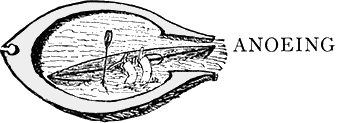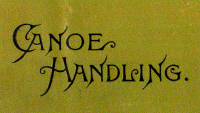
CANOEING. I. IN GENERAL.
- "I've traveled all the world around,
- From China Seas to Puget Sound,
- In every Sort of craft that floats,
- From schooners down to jolly-boats;
- And for calm or storm my choice is made
- of a staunch canoe and a paddle blade.
- So I toast the man, whoever he be,
- That first shaped paddle from the tree."
is the art, pastime or science of the navigation of a canoe. What is a canoe? That is your first question; or if not, it should be. If you consult the dictionary for the meaning of the word canoe, you will learn something; but be very shy of a little knowledge on any subject. In this case the facts obtained from the lexicon will probably lead you to believe that the canoe is only made and used by savages, and you may think any further knowledge on the subject of no practical use to you, personally. Well! have patience; read what follows, and then perhaps you will change your mind -- as many have done before YOU.
10. • Canoe Handling. • Capabilities.
Before telling you what a canoe now is and how to use one, if you do not already know, perhaps it will be as well to interest you, if possible, by stating a few facts as to what the canoe can give you, what she is capable of, and what she has done. A little information as to what canoeing is may induce you to read still further and learn what the canoe is. The time-honored usage in referring to boats as feminine you see is followed here.The canoe is not a fickle, but a very shy and modest little puss, and she must be long and faithfully wooed -- gently withal -- before she is won. Once conquered she is docility itself, and obedient. A more faithful traveling companion you cannot find. She will show you the choicest bits of nature, un-got-at-able except with her aid. She will shelter you miles from civilization, will carry you and your luxuries and necessities by day down rivers, across lakes, along the sounds and bays of the coast and will ask very little in return -- a coat of varnish twice a year, a few brass screws now and then, a little care of her and nothing more.
A comfortable seat is provided for you with a back to it and facing the way you are going. You are tired paddling; a favorable breeze springs up, the sail is set and you are moving four, five, yes seven miles an hour without doing more than keeping a lookout ahead and around, and resting one hand on the tiller.
Canoes have been used for exploration and the gathering of facts. An author has cruised from Labrador to Cape Breton, the entire length of the Gulf of St. Lawrence Coast, and noted the life and manners of a strange people -- the French Canadians -- in many a nook and corner. He has shared the knowledge with us all in numerous illustrated magazine articles. MacGregor's cruises on the Rhine, Jordan and Baltic Sea have been published. Bishop has written a book about his 2500-mile cruise from Quebec to Florida and the Gulf. Dr. Neidé's cruise down the Ohio and Mississippi rivers has also appeared in print. These are charming books, all of them. Several of the leading magazines have contained articles on canoeing -- The Century, Harper's, Outing and others. Forest and Stream for five years has had articles and news in its canoe department every week.
Perhaps you are a married man. You would like to go canoeing, but -- Well! take her with you, and them too, if you like. This has often been done. There is plenty of room for two if you manage well -- and don't "fall out." Live in a large city, do you? Have no vacation to speak of! Plenty of water about you, but "no time." Do you know that you can alone lift the canoe from the boathouse into the water, get in just as you are in your "shore clothes," have an hour's paddle and return home to dine of a summer's afternoon, a better man for the open air exercise?
Too old? Indeed ! Gray hair, you say; or did you mention baldness?
12. • Canoe Handling. • The Scope of Canoeing.
You will find companions grayer and more bald than you are in almost every canoe club. At the yearly meets of the American Canoe Association, when every member who can takes a two weeks' vacation in which to meet "the boys," if you attend one, you will see the lion -- a graybeard of sixty -- lying down beside the lamb still at school, when night comes and all seek the rest and retirement that pure air and a tent shelter grant. Ministers, doctors, professors, lawyers, artists, statesmen, editors, merchants, clerks, manufacturers and men of leisure -- all are of us and with us. Will you join the clan? Age, means, occupation nor sex can stand in your way if you once taste the delights afforded by a canoe. This is all true. If you do not believe it and are not interested, do not read another word, as you will find it grows dryer as you go on. If you have been touched, the dryness may prove like that of champagne.There are canoes -- and canoes. If you have not seen a modern civilized canoe, the word probably brings to mind pictures you have seen of the Indian in the birch, the Esquimau in his kayak, or perchance the cannibals in "Robinson Crusoe" paddling canoes which are but hollowed-out logs having the ends sharpened. The craft this book is to treat of is none of these, but it is derived directly from them and has all their good qualities and many more of its own. Our canoe is neither bark, skins nor a log, but a canoe -- having decided limitations, especially in the matter of size and great possibilities.
Canoeing does not mean only cruising, as some writers would have us believe. Perhaps too much emphasis has been given to cruising to the detriment of canoeing generally. If you get a canoe, use it for whatever your time and inclination dictate hunting, fishing, exercise, sailing, racing, drifting, short trips, long cruises, exploration, as the means of enjoying a (male or female) friend's exclusive society, to recreation of tired faculties -- in short, do as you like with it, even to varnishing, rigging, "monkeying" and polishing. Though you never go afloat, you will derive pleasure and benefit from the canoeing, and can slap your chest and sing, "I am a canoeist, I."
© 2000 Craig O'Donnell
May not be reproduced without my permission.


